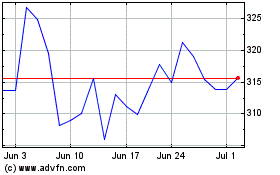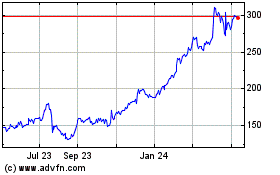By Anne Steele and Tripp Mickle
Apple Music has surpassed Spotify Technology SA in paid U.S.
subscriptions, according to people familiar with the matter, in a
shift that escalates the music rivals' contest for listeners
world-wide.
Apple Inc.'s streaming-music service has been adding subscribers
in the world's biggest music market more rapidly than its Swedish
rival -- a monthly growth rate of about 2.6% to 3%, compared with
1.5% to 2% for Spotify -- the people said.
Apple Music had more than 28 million subscribers in the U.S. as
of February, compared with Spotify's 26 million, the people said.
Neither service publicly breaks out regional subscriber counts, and
those figures include only paying users, excluding those in trial
offerings that the companies can count in their public subscriber
disclosures. Including nonpaying listeners of its ad-supported
tier, who generate a fraction of the revenue subscribers do,
Spotify has more users overall in the U.S.
Apple was expected to reach its milestone more than six months
ago, but Spotify intensified efforts to maintain its lead,
expanding various promotions including a discounted subscription
bundle with video-streaming service Hulu. More recently, the
Swedish company filed an antitrust complaint in Europe claiming
Apple abuses its control over the App Store to advantage the iPhone
maker's service, something Apple denies.
Dow Jones & Co., publisher of The Wall Street Journal, has a
commercial agreement to supply news through Apple services.
Meanwhile, Spotify said in February that it agreed to buy podcaster
Gimlet Media, with which The Wall Street Journal also has a content
partnership.
Spotify remains far ahead of Apple globally. As of December,
Spotify said it had 207 million active users around the world, 96
million of whom are paying subscribers or in a trial period leading
to a subscription. The rest of Spotify's active users have opted
for a free, ad-supported version of the service. Apple, which
doesn't offer a free, ad-supported option, has more than 50 million
paying subscribers.
The growth of Apple Music is one of the strongest validations
yet of Apple's strategy to increase revenue by selling services
across its devices -- a shift after decades of focusing on hardware
sales. Last week, the technology company announced new subscription
offerings for magazines, TV shows and videogames.
The push into subscriptions comes as Apple's bread-and-butter
iPhone business struggles. In January, the company reported its
first decline in sales and profits for the holiday period after
iPhone sales fell 15% to $52 billion. Services, which includes
streaming-music subscriptions, device insurance and mobile
payments, blunted those declines, rising 19% to $10.88 billion in
the period.
As streaming has become the most popular way people listen to
music -- and the most lucrative source of growth for the recording
industry -- subscriptions have become the most closely watched
metric for the services competing to grow market share.
Apple Music is growing faster globally -- at a rate of about
2.4% to 2.8%, compared with Spotify's 2% to 2.3% -- and the gap is
starting to close in other markets outside the U.S., according to
the people familiar with the numbers.
Apple Music's momentum is particularly pronounced in the other
large, English-speaking territories where iTunes, the company's
music-download store, was popular and where iPhone usage is
high.
Apple has used its devices' popularity to attract
music-streaming users. The Apple Music app comes preloaded on
iPhones and other Apple hardware. The company has a base of about
101 million active iPhones in the U.S., according to Strategy
Analytics, a market research firm.
The service is also available on Android devices and has been
installed about 40 million times world-wide from the Google Play
store, according to the app-tracking firm Sensor Tower.
Offers tying subscriptions to mobile-phone services have also
helped Apple make significant inroads. For example, the company
this month joined with Verizon Communications Inc. to provide six
months of Apple Music free to new and current customers.
It has used its marketing muscle to accelerate subscriptions,
spending twice as much as Spotify on TV ads in the U.S. since 2016,
with spots during National Football League games, awards shows and
other big events, according to ad measurement firm iSpot.tv.
Spotify, which went public last year, has responded with
offerings of its own, including an offer of free Hulu access with
premium subscriptions. It also has extended discounts -- three
months of its premium service for 99 cents -- that drive much of
its subscriber growth, according to people familiar with the
matter.
The streaming-music service is trying to counter Apple's
distribution advantage of 1.4 billion active devices through an
agreement struck in August with Samsung Electronics Co., making
Spotify the default music service across the South Korean company's
phones, TVs and speakers.
Apple Chief Executive Tim Cook, on a call with analysts last
year, played down the competition among streaming-music providers,
pointing instead to the potential size of the subscriber
market.
Despite its growth, Apple's streaming-music business isn't
expected to lift company profits. Costs associated with paying
labels, publishers and artists means the service has a gross margin
of roughly 15%, the lowest of any of Apple's services, according to
RBC Capital Markets.
"From Apple's perspective, they're not looking at this business
for overall dollars," said Ben Bajarin, an analyst with the
technology firm Creative Strategies. "It's about making the value
of their hardware go up."
Write to Anne Steele at Anne.Steele@wsj.com and Tripp Mickle at
Tripp.Mickle@wsj.com
(END) Dow Jones Newswires
April 05, 2019 11:06 ET (15:06 GMT)
Copyright (c) 2019 Dow Jones & Company, Inc.
Spotify Technology (NYSE:SPOT)
Historical Stock Chart
From Mar 2024 to Apr 2024

Spotify Technology (NYSE:SPOT)
Historical Stock Chart
From Apr 2023 to Apr 2024
